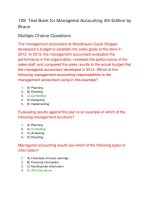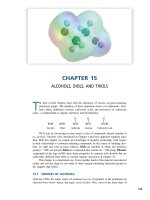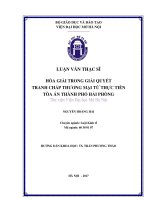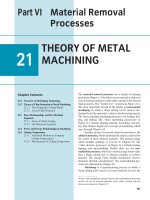Ebook : HYDRAULIC STRUCTURES 4TH EDITION BY P. NOVAK, A.I.B, MOFFAT, C. NALLURI AND R. NARAYANAN
Bạn đang xem bản rút gọn của tài liệu. Xem và tải ngay bản đầy đủ của tài liệu tại đây (6.1 MB, 725 trang )
Hydraulic Structures
Also available from Taylor & Francis
Hydraulics in Civil and Environmental Engineering 4th edition
A. Chadwick et al.
Hardback: ISBN 978-041-530608-9
Paperback: ISBN 978-041-530609-6
Mechanics of Fluids 8th edition
B. Massey, by J. Ward Smith
Hardback: ISBN 978-0-415-36205-4
Paperback: ISBN 978-0-415-36206-1
Practical Hydraulics 2nd edition
M. Kay
Hardback: ISBN 978-0-415-35114-0
Paperback: ISBN 978-0-415-35115-7
Hydraulic Canals
J. Liria
Hardback: ISBN 978-0-415-36211-5
Information and ordering details
For price availability and ordering visit our website www.sponpress.com
Alternatively our books are available from all good bookshops.
Hydraulic Structures
Fourth Edition
P. Novak, A.I.B. Moffat and C. Nalluri
School of Civil Engineering and Geosciences,
University of Newcastle upon Tyne, UK
and
R. Narayanan
Formerly Department of Civil and Structural Engineering, UMIST,
University of Manchester, UK
Fourth edition published 2007 by Taylor & Francis
2 Park Square, Milton Park, Abingdon, Oxon OX14 4RN
Simultaneously published in the USA and Canada
by Taylor & Francis
270 Madison Ave, New York, NY 10016
Taylor & Francis is an imprint of the Taylor & Francis Group, an informa business
This edition published in the Taylor & Francis e-Library, 2006.
“To purchase your own copy of this or any of Taylor & Francis or Routledge’s
collection of thousands of eBooks please go to www.eBookstore.tandf.co.uk.”
© 1990, 1996, 2001, 2007 Pavel Novak, Iain Moffat, the estate of Chandra
Nalluri and Rangaswami Narayanan
The right of Pavel Novak, Iain Moffat, Chandra Nalluri and Rangaswami
Narayanan to be identified as the Authors of this Work has been asserted by
them in accordance with the Copyright, Designs and Patents Act 1988
All rights reserved. No part of this book may be reprinted or reproduced or
utilized in any form or by any electronic, mechanical, or other means, now
known or hereafter invented, including photocopying and recording, or in any
information storage or retrieval system, without permission in writing from the
publishers.
The publisher makes no representation, express or implied, with regard to the
accuracy of the information contained in this book and cannot accept any legal
responsibility or liability for any efforts or omissions that may be made.
British Library Cataloguing in Publication Data
A catalogue record for this book is available from the British Library
Library of Congress Cataloging in Publication Data
Hydraulic structures / P. Novak . . . [et al.]. — 4th ed.
p. cm.
Includes bibliographical references and index.
ISBN-13: 978-0-415-38625-8 (alk. paper)
ISBN-13: 978-0-415-38626-5 (pbk. : alk. paper)
1. Hydraulic structures. I. Novák, Pavel.
TC180.H95 2007
627--dc22
ISBN 0-203-96463-2 Master e-book ISBN
ISBN10: 0-415-38625-X Hardback
ISBN10: 0-415-38626-8 Paperback
ISBN10: 0-203-96463-2 e-book
ISBN13: 978-0-415-38625-8 Hardback
ISBN13: 978-0-415-38626-5 Paperback
ISBN13: 978-0-203-96463-7 e-book
Contents
Preface
Preface to the third edition
Preface to the second edition
xi
xiii
xv
Preface to the first edition
xvii
Acknowledgements
xix
List of tables
xx
List of main symbols
Part One Dam engineering
xxii
1
1
Elements of dam engineering
1.1
General
1.2
Introductory perspectives
1.3
Embankment dam types and characteristics
1.4
Concrete dam types and characteristics
1.5
Spillways, outlets and ancillary works
1.6
Site assessment and selection of type of dam
1.7
Loads on dams
References
3
3
4
12
16
20
23
35
39
2
Embankment dam engineering
2.1
Introduction
2.2
Nature and classification of engineering soils
2.3
Engineering characteristics of soils
42
42
42
47
vi
CONTENTS
2.4
Principles of embankment dam design
2.5
Materials and construction
2.6
Seepage analysis
2.7
Stability and stress
2.8
Settlement and deformation
2.9
Rockfill embankments and rockfill
2.10
Small embankment dams, farm dams and flood banks
2.11
Tailing dams and storage lagoons
2.12
Geosynthetics in embankment dams
2.13
Upgrading and rehabilitation of embankment dams
Worked examples
References
60
73
78
82
97
100
103
107
108
109
111
116
3
Concrete dam engineering
3.1
Loading: concepts and criteria
3.2
Gravity dam analysis
3.3
Buttress dam analysis
3.4
Arch dam analysis
3.5
Design features and construction
3.6
Concrete for dams
3.7
The roller-compacted concrete gravity dam
3.8
Upgrading of masonry and concrete dams
Worked examples
References
122
122
133
155
157
164
170
174
180
182
188
4
Dam outlet works
4.1
Introduction
4.2
The design flood
4.3
Flood routing
4.4
Freeboard
4.5
Sedimentation in reservoirs
4.6
Cavitation
4.7
Spillways
4.8
Bottom outlets
Worked examples
References
191
191
192
195
197
200
204
206
231
234
239
5
Energy dissipation
5.1
General
5.2
Energy dissipation on spillways
5.3
Stilling basins
5.4
Plunge pools
5.5
Energy dissipation at bottom outlets
Worked examples
References
244
244
245
249
259
261
262
264
CONTENTS
6
Gates and valves
6.1
General
6.2
Crest gates
6.3
High-head gates and valves
6.4
Tidal barrage and surge protection gates
6.5
Hydrodynamic forces acting on gates
6.6
Cavitation, aeration, vibration of gates
6.7
Automation, control and reliability
Worked example
References
267
267
268
275
277
279
283
284
285
287
7
Dam safety: instrumentation and surveillance
7.1
Introduction
7.2
Instrumentation
7.3
Surveillance
7.4
Dam safety legislation
7.5
Reservoir hazard and risk assessment
References
289
289
291
304
306
309
315
Part Two
Other hydraulic structures
319
8
River engineering
8.1
Introduction
8.2
Some basic principles of open-channel flow
8.3
River morphology and régime
8.4
River surveys
8.5
Flow-measuring structures
8.6
River flood routing
8.7
River improvement
Worked examples
References
321
321
322
327
331
337
338
342
353
360
9
Diversion works
9.1
Weirs and barrages; worked examples
9.2
Intakes; worked examples
9.3
Fish passes
References
364
364
392
410
416
10 Cross-drainage and drop structures
418
10.1
Aqueducts and canal inlets and outlets; worked examples 418
10.2
Culverts, bridges and dips; worked examples
428
10.3
Drop structures; worked example
448
References
458
vii
viii
CONTENTS
11 Inland waterways
11.1
Introduction
11.2
Definitions, classification and some waterways
11.3
Multipurpose utilization of waterways
11.4
Transport on inland waterways
11.5
Canalization and navigation canals
11.6
Resistance of ships
11.7
Wave action on banks
11.8
Locks
11.9
Thrift locks
11.10 Lifts and inclined planes
11.11 Lock approaches
11.12 Inland ports
Worked examples
References
461
461
463
466
469
471
473
475
477
486
488
490
491
493
494
12 Hydroelectric power development
12.1
Introduction
12.2
Worldwide hydroelectric power development
in perspective
12.3
Power supply and demand
12.4
Some fundamental definitions
12.5
Types of water power development
12.6
Head classification of hydropower plants
12.7
Streamflow data essential for the assessment of
water-power potential
12.8
Hydraulic turbines and their selection
12.9
Other components of hydropower plants
12.10 Surge tanks
12.11 Small hydraulic power plant development
12.12 Other energy resources
Worked examples
References
496
496
13 Pumping stations
13.1
Introduction
13.2
Pumps and their classification
13.3
Design of pumping mains
13.4
Classification of pumping stations and intakes
13.5
Sump design
13.6
Screening devices
13.7
Benching
13.8
Surges
13.9
General design considerations of pumping stations
and mains
548
548
548
554
557
559
562
562
562
497
497
498
499
502
502
505
517
525
529
530
533
546
566
CONTENTS
Worked examples
References
568
574
14 Waves and offshore engineering
14.1
Introduction
14.2
Wave motion
14.3
Range of validity of linear theory
14.4
Waves approaching a shore
14.5
Wave breaking
14.6
Wave reflection
14.7
Basin oscillations
14.8
Wave diffraction
14.9
Wave prediction
14.10 Wave statistics
14.11 Forces on cylindrical structures
14.12 Vortex-induced oscillations
14.13 Oscillations of cylinders in waves
Worked examples
References
575
575
576
584
586
588
591
592
593
594
599
602
612
617
618
624
15 Coastal engineering
15.1
Introduction
15.2
Coastal defence
15.3
Wave forces on coastal structures
15.4
Wave run-up
15.5
Wave overtopping
15.6
Rubble-mound breakwaters
15.7
Sea outfalls
15.8
Coastal management
Worked examples
References
627
627
629
636
641
645
647
653
662
663
670
16 Models in hydraulic engineering
16.1
Hydraulic models
16.2
Structural models
Worked example
References
674
674
683
687
688
Author index
691
Subject index
696
ix
Preface
The aim of the book, to provide a text for final year undergraduate and
postgraduate students, remains the same as in the previous editions; we
also trust that researchers, designers and operators of hydraulic structures
will continue to find the text of interest and a stimulating up-to-date
reference source.
This new edition enabled us to update the text and references
throughout, and to introduce some important changes and additions reacting to new developments in the field. We have also taken note of some
comments received on the previous edition; particular thanks for the constructive comments and help provided by Professor J. Lewin in redrafting
Chapter 6 (Gates and valves).
The authorship of individual chapters remains the same as in previous editions; (Dr Narayanan carried out the work on this edition during
his stay in the Faculty of Civil Engineering, Universiti Teknologi Malaysia,
Johor Bahru, Malaysia). However, as our colleague Dr C. Nalluri unfortunately died in December 2003 ‘his’ text was reviewed by Dr Narayanan
(Chapter 13) and Professor Novak (Chapters 9, 10 and 12) who also again
edited the whole text.
Readers of the previous (2001) edition may note the following major
changes:
Chapter 1.
Chapter 2.
Chapter 3.
Enhanced discussion of environmental issues including the
World Commission on Dams report.
New sections on partially saturated soils, small farm and
amenity dams, tailing dams and lagoons and upgrading and
rehabilitation of embankment dams; extended treatment of
upstream face protection/rock armouring.
Extended discussion of roller-compacted concrete dams
and a new section on upgrading of masonry and concrete
dams.
xii
PREFACE
Chapter 4.
Chapter 5.
Chapter 6.
Chapter 7.
Chapter 9.
Chapter 12.
Chapter 14.
Chapter 15.
Chapter 16.
Substantially enhanced discussion of flow over stepped spillways.
Extended treatment of scour in plunge pools.
Enlarged treatment of hydrodynamic forces acting on low
and high-head gates and new sections dealing with cavitation, aeration and vibrations of gates and automation,
control and reliability.
Increased coverage of integrated risk analysis/management
and contingency/emergency planning in dam safety.
Inclusion of barrages with raised sill.
New text on small hydraulic power development and tidal
and wave power.
More detailed treatment of wave breaking, wave statistics
and pipeline stability.
Enhanced treatment of beach profile and wave/structure
interaction and a new section on coastal modelling.
Enlarged discussion of mathematical, numerical and computational models in hydraulic engineering.
In order not to increase the size of the book unduly some less relevant
material has been omitted (particularly in Ch. 12).
P. Novak, A.I.B. Moffat and R. Narayanan
Newcastle upon Tyne, June 2006
Preface to the third
edition
The main aim of the book, i.e. to provide a text for final year undergraduate and for postgraduate students, remains the same as for the previous
two editions; we also hope that researchers, designers and operators of the
many types of structures covered in the book will continue to find the text
of interest and a stimulating, up-to-date reference source.
It is now almost six years since the manuscript of the second edition
was completed and this new edition gave us the opportunity to correct the
few remaining errors and to update the text and references throughout. At
the same time, as a reaction to some important developments in the field,
certain parts of the text have been rewritten, enlarged or reorganized.
Readers of the second edition may wish to note the following major
changes:
Chapter 1.
Chapter 2.
Chapter 4.
Chapter 6.
Chapter 7.
Chapter 9.
Chapter 14.
The environmental and social issues associated with major
reservoir projects are addressed in greater depth.
New section on small embankments and flood banks and
expanded discussion of seismicity and seismic analysis.
Enlarged text on design flood selection and reservoir flood
standards, aeration on spillways and in free flowing tunnels;
extended treatment of stepped spillways.
A new section on tidal barrage and surge protection gates
and enlarged text on forces acting on gates; a new worked
example.
Enhanced text on reservoir hazard analysis and dam break
floods.
New paragraph on pressure distribution under piled foundation floors of weirs with a new worked example.
This chapter – Coastal and offshore engineering in previous
edition – has been divided into:
Chapter 14 ‘Waves and offshore engineering’ and
xiv
PREFACE TO THE THIRD EDITION
Chapter 16.
Chapter 15 ‘Coastal engineering’
Consequently the whole material has been reorganized. The
treatment of forces on cylindrical bodies in waves and currents has been significantly extended in Chapter 14. Chapter
15 now includes an extended treatment of wave overtopping
and stability of breakwaters as well as a brief discussion of
coastal management.
(formerly ch. 15). Extended discussion of computational
modelling of hydraulic structures.
P. Novak, A.I.B. Moffat, C. Nalluri and R. Narayanan
Newcastle upon Tyne, August 2000
Preface to the second
edition
The main aim of the book, i.e. to provide a text for final year undergraduate and for postgraduate students, remains the same as for the first edition;
equally we hope that researchers, designers and operators of the many
types of hydraulic structures covered in the book will find the text of interest and a useful reference source.
We took the opportunity of a new edition to correct all (known)
errors and to thoroughly update the text and references throughout. At
the same time as a response to received comments and reviews as well as a
reaction to some new developments in the field, certain parts of the text
were rewritten or enlarged. Readers of the first edition may wish to note
the following major changes.
Chapter 1.
Chapter 2.
Chapter 3.
Chapter 4.
Chapter 5.
Chapter 6.
Chapter 7.
Chapter 8.
Chapter 9.
Extended text on site assessment for dams.
Expanded treatment of geotechnical aspects, e.g. a new
paragraph (2.8.3) on performance indices for earthfill cores,
and a new brief section (2.10) on geosynthetics.
Extended coverage of RCC dams with a new paragraph
(3.7.3) dealing with developments in RCC construction.
Enlarged text dealing with design flood estimation, reservoir
sedimentation, interference waves and aeration on spillways
and a new paragraph (4.7.6) on stepped spillways.
Enlarged section on scour below spillways.
A new paragraph (6.2.8) on overspill fusegates.
Enlarged text on reservoir downstream hazard assessment.
Enlarged text on multistage channels, geotextiles, Crump
weir computation and a new section (8.6) on river flood
routing.
Extended text on fish passes and a new paragraph (9.1.6)
on the effect of the operation of barrages on river water
quality.
xvi
PREFACE TO THE SECOND EDITION
Chapter 10.
Chapter 13.
Chapter 14.
Chapter 15.
Enlarged text on canal inlets and scour at bridges and below
culvert outlets.
A new short section (13.7) on benching.
Change of title (from Coastal engineering) to Coastal and
offshore engineering incorporating a substantial new section
(14.7) on sea outfalls and the treatment of wave forces on
pipelines in the shoaling region.
Change of title (from Scale models in hydraulic engineering)
to Models in hydraulic engineering to include in the general
discussion of hydraulic models (15.1.1) a typology of mathematical models; also included a short paragraph (15.2.4) on
modelling of seismic response.
The authors would like to thank the reviewers for their constructive comments and the publisher for providing the opportunity for this second
edition.
P. Novak, A.I.B. Moffat, C. Nalluri and R. Narayanan
Newcastle upon Tyne, December 1994
Preface to the first
edition
This text is loosely based on a course on ‘Hydraulic Structures’ which
evolved over the years in the Department of Civil Engineering at the University of Newcastle upon Tyne. The final-year undergraduate and
Diploma/MSc postgraduate courses in hydraulic structures assume a good
foundation in hydraulics, soil mechanics, and engineering materials, and
are given in parallel with the more advanced treatment of these subjects,
and of hydrology, in separate courses.
It soon became apparent that, although a number of good books may
be available on specific parts of the course, no text covered the required
breadth and depth of the subject, and thus the idea of a hydraulic structures
textbook based on the course lecture notes came about. The hydraulic
structures course has always been treated as the product of team-work.
Although Professor Novak coordinated the course for many years, he and
his colleagues each covered those parts where they could make a personal
input based on their own professional experience. Mr Moffat, in particular,
in his substantial part of the course, covered all geotechnical engineering
aspects. In the actual teaching some parts of the presented text may, of
course, have been omitted, while others, particularly case studies (including
the discussion of their environmental, social, and economic impact), may
have been enlarged, with the subject matter being continuously updated.
We are fully aware that a project of this kind creates the danger of
presenting the subject matter in too broad and shallow a fashion; we hope
that we have avoided this trap and got it ‘about right’, with worked
examples supplementing the main text and extensive lists of references
concluding each chapter of the book.
This text is not meant to be a research monograph, nor a design
manual. The aim of the book is to provide a textbook for final-year
undergraduate and postgraduate students, although we hope that
researchers, designers, and operators of the many types of hydraulic structures will also find it of interest and a useful reference source.
xviii
PREFACE TO THE FIRST EDITION
The text is in two parts; Part One covers dam engineering, and Part
Two other hydraulic structures. Mr A.I.B. Moffat is the author of Chapters 1, 2, 3 and 7, and of section 15.2. Dr C. Nalluri wrote Chapters 9, 10,
12 and 13, and sections 8.4 and 8.5. Dr R. Narayanan of UMIST was
invited to lecture at Newcastle for two years, on coastal engineering, and is
the author of Chapter 14. The rest of the book was written by Professor
P. Novak (Chapters 4, 5, 6 and 8, except for sections 8.4 and 8.5, Chapter
11 and section 15.1), who also edited the whole text.
P. Novak, A.I.B. Moffat, C. Nalluri and R. Narayanan
Newcastle upon Tyne, 1989
Acknowledgements
We are grateful to the following individuals and organizations who have
kindly given permission for the reproduction of copyright material (figure
numbers in parentheses):
Thomas Telford Ltd (4.1, 4.2); US Bureau of Reclamation (4.3, 4.7,
4.15, 4.16, 5.6, 5.7); Elsevier Science Publishers (4.5, 4.12, 4.13, 5.5, 5.8,
5.10. 11.1, 11.2, 11.10, 11.11, 11.16, 11.17, 11.18, 12.17); British Hydromechanics Research Association (4.11, 13.6, 13.9); Institution of Water
and Environmental Management (4.18); ICOLD (4.19, 4.20); Figures 4.21,
6.2, 6.3, 6.4 reproduced by permission of John Wiley & Sons Ltd, from
H.H. Thomas, The Engineering of Large Dams, © 1976; C.D. Smith (6.6,
6.7); MMG Civil Engineering Systems Ltd (8.20); E. Mosonyi (9.12, 9.13,
12.17); International Institute for Land Reclamation and Improvement,
the Netherlands (10.14, 10.15); Morgan-Grampian Book Publishing (11.1,
11.5); Delft Hydraulics (11.7); Macmillan (14.12); C.A.M. King (14.13);
C. Sharpe (11.2); J. Lewin (6.1, 6.2).
Cover image courtesy of Ingetec S.A. Colombia (Dr A. Marulanda)
List of tables
1.1
1.2
1.3
1.4
1.5
1.6
1.7
2.1
2.2
2.3
2.4
2.5
2.6
2.7
2.8
3.1
3.2
3.3
3.4
3.5
3.6
3.7
3.8
3.9
3.10
3.11
4.1
7.1
Large dams: World Register statistics
Summary of numbers of British, US and Chinese dams
Highest dams
Largest-volume dams
Dams with largest-capacity reservoirs
Notional foundation stresses: dams 100 m in height
Dam selection: type characteristics
Representative physical characteristics of soils
Descriptive consistency of clay soils
Illustrative engineering properties for selected soil types
Embankment dam defect mechanisms and preventive
measures
Characteristics of core soils
Indicative engineering properties for compacted earthfills
Guideline factors of safety: effective stress stability analysis
Seismic acceleration coefficients, ␣h, and earthquake
intensity levels
Seismic pressure factors, Ce
Nominated load combinations
Range of shearing resistance parameters
Foundation rock shear strength characteristics
Examples of shear strength degradation
Recommended shear friction factors, FSF
Comparative sliding stability factors: triangular gravity profile
Permissible compressive stresses
Illustrative values for coefficient, K0
Characteristics of mass concrete for dams
Characteristics of RCCs for dams
Flood, wind and wave standards by dam category
Selected major dam disasters 1959–1993
4
5
6
6
6
32
34
47
52
57
64
74
75
85
94
131
132
137
137
138
141
143
147
154
173
177
194
290
LIST OF TABLES
7.2
7.3
8.1
9.1
9.2
10.1
10.2
10.3
10.4
10.5
10.6
10.7
11.1
12.1
12.2
12.3
12.4
13.1
13.2
13.3
15.1
15.2
15.3
15.4
15.5
16.1
Primary monitoring parameters and their relationship to
possible defects
Representative monitoring frequencies
Types of weir
Correction factors for submerged (non-modular) flows
Values of  for parallel flow
Types of flow in the barrel of a culvert
Bridge loss coefficient, KB
Values of K as a function of pier shape
Values of KN and KA
Permissible velocities to withstand erosion
Range of values of C for free flow over the embankment
Correction factor, f (non-modular flows)
Freight on inland waterways: annual throughput of shipping
Range of values, specific speeds and heads
Q–H–Ns data
Runaway speeds and acceptable head variations
Critical plant sigma values, c
Types of pumps and their applications
Specific speeds for rotodynamic pumps
Sludge flow head losses
Factor r for various armour units
Values of coefficients A and B for simple sea walls
Values of KD in Hudson’s formula (SPM): no damage
and minor overtopping
Layer coefficient KЈD and porosity for various armour units
Variation in damage number for failure conditions
Scale factors
294
304
339
382
397
429
435
437
439
442
443
443
469
507
509
510
511
550
551
568
644
646
649
650
652
680
xxi
Main symbols
a
A
b
B
_
B
c
C
Cd
CD
Cv
d
D
E
e
f
F
FD
Fr
FSL
g
GWL
hЈ
h
H
Hs
HFL
i
I
constant, gate opening, pressure wave celerity, wave amplitude
cross-sectional area
breadth, channel width, constant, length of wave crest
water surface width
porewater pressure coefficient
apparent cohesion, coefficient, constant, unit shearing strength,
wave celerity
Chezy coefficient, coefficient, concentration
coefficient of discharge
drag coefficient
coefficient of consolidation, coefficient of velocity
depth, diameter, sediment grain size
diameter, displacement of vessels
cut-off (core) efficiency, energy, Young’s modulus
energy loss, pipe wall thickness
correction factor, frequency, function, Lacey’s silt factor
factor of safety, fetch, force, function
drag force
Froude number
full supply level
gravitational acceleration
ground water level
uplift pressure head
head, pump submergence, rise of water level above SWL, stage
total energy (head), head (on spillway etc.), wave (embankment)
height
seepage head, significant wave height, static lift
high flood level
hydraulic gradient
inflow, influence factor, moment of inertia
MAIN SYMBOLS
k
K
Kc
l
L
m
mv
M
n
N
Nd
Nf
Ns
NWL
O
p
pv
P
q
Q
Qs
r
ru
R
Re
Rs
S
Sc
Sf
S0
Sh
SWL
t
T
u
uw
U
U*
V
Vc
w
ws
W
coefficient (of permeability), effective pipe roughness, wave
number
bulk modulus, channel conveyance, coefficient
Keulegan–Carpenter number
length
length, wavelength
mass
coefficient of volume compressibility
moment
Manning roughness coefficient
hydraulic exponent speed in rev/min
number of increments of potential in flownet
number of flow channels in flownet
specific speed
normal water level
outflow
number of poles, pressure intensity
vapour pressure
force, power, wetted perimeter
specific discharge
discharge
discharge of sediment
factor, radius
pore pressure ratio
hydraulic radius, resistance, resultant, radius
Reynolds number
régime scour depth
maximum shearing resistance, slope
critical slope
friction slope
bed slope
Strouhal number
still water level
thickness, time
draught, time, wave period
local velocity (x direction)
porewater pressure
wind speed
shear velocity
velocity (general), velocity (y direction)
mean cross-sectional velocity, storage, volume
critical velocity
moisture content, velocity (z direction)
sediment fall velocity
régime width, weight
xxiii
xxiv
MAIN SYMBOLS
x
y
yЈ
yϩ
yc
ym
ys
z
␣

␥
␦
␦Ј
∆
⑀
µ
v
s
1,2,3
Ј
c
0
distance, x coordinate
flow depth, y coordinate
stilling basin depth
depth of centroid of section A
critical depth
mean depth (ϭ A/B)
maximum scour (local) depth, turbine setting
depth, elevation relative to datum, z coordinate
angle, constant, energy (Coriolis) coefficient, (seismic)
coefficient, wave crest angle
angle, momentum (Boussinesq) coefficient, slope, angle
specific (unit) weight (ϭ pg)
boundary layer thickness, deflection settlement
laminar sublayer thickness
relative density of sediment in water ((s Ϫ )/)
strain
area reduction coefficient, efficiency
angle, velocity coefficient
Darcy–Weisbach friction factor, flownet scale transform factor
dynamic viscosity of water
kinematic viscosity of water, Poisson ratio
coefficient (head loss), parameter
density of water
density of sediment particle
cavitation number, conveyance ratio, safety coefficient, stress,
surface tension
major, intermediate and minor principal stresses
effective stress, safety coefficient
shear stress, time interval
critical shear stress
boundary shear stress
angle of shearing resistance or internal friction, function,
sediment transport parameter, speed factor
flow parameter
angular velocity (radians sϪ1)









